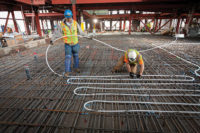
The HVAC aspect was emphasized with representation from four major industry manufacturers - Honeywell, Johnson Controls Inc., Siemens, and Trane - along with a number of industry associations. In the initial announcement about the C-40 initiative, it was reported that all four companies would conduct energy audits, perform building retrofits, and guarantee the energy savings of the retrofit projects. The guaranteeing of savings is the basic premise of performance contracting.
The Mechanical Contractors Association of America (MCAA) announced that it had signed a Memorandum of Understanding (MOU) with the Clinton Climate Initiative of the William J. Clinton Foundation to provide technical assistance for the development and implementation of the Energy Efficiency Building Retrofit Program announced in New York.
Under the MOU, MCAA lent its expertise and experience to the Clinton Climate Initiative as endeavors to provide large cities with world-class technical assistance on an array of actions, that cities might implement to lower greenhouse gas emissions, got underway.
The U.S. Green Building Council (USGBC) and the American Society for Heating, Refrigerating, and Air-Conditioning Engineers (ASHRAE) have agreed to help coordinate training programs in participating cities.
“ASHRAE is in the best position to provide immediate support to the cities seeking guidance through the Clinton Climate Initiative due to our 30-year involvement in design guidance for energy conservation for both new and existing buildings,” said Terry Townsend, president, ASHRAE.
Townsend said ASHRAE is working to provide energy guidance on existing buildings through its Advanced Energy Design Guide Series, developed with the Illuminating Engineering Society of North America and the USGBC with participation of Building Owners and Managers Association (BOMA) and the U.S. General Service Administration. The guidelines “will show building owners how they can initially reduce their energy consumption by 30 percent,” Townsend said, noting the information is tentatively scheduled to be available in fall 2008.
As green topics flooded the market in 2007, research and statistics began surfacing in a new light - a green light. According to the Clinton Climate Initiative, urban areas are responsible for approximately 75 percent of all energy use and greenhouse gas emissions in the world. Buildings account for nearly 40 percent of global greenhouse gas emissions, and in cities, that percentage is even higher. In newer cities, buildings can account for 50 percent of greenhouse gas emissions and in older cities 70 percent.
The Energy Efficiency Building Retrofit Program, a project of the Clinton Climate Initiative, not only provides funds to retrofit existing buildings with more energy-efficient products, but it also brings together the world’s four largest energy service companies (ESCOs) with five of the world’s largest banks to retrofit buildings. The banking partners committed to arrange $1 billion in financing, each for a total of $5 billion for this program, more than doubling the current market for building retrofits. The financing will be repaid from the energy savings that the retrofit projects will achieve.
Amidst all the rhetoric and speech making, there was one underlying point: The firepower of a Clinton-backed initiative means potential widespread attention and capital. And if concerns raised can at least in part be addressed by HVAC contractors, the money could well be there to do the installs and retrofits.
“The businesses, banks, and cities partnering with my foundation are addressing the issue of global warming because it’s the right thing to do,” said Clinton, “and because it’s good for their bottom line. They’re going to save money, make money, create jobs, and have a tremendous collective impact on climate change all at once.”
Publication Date:12/24/2007






